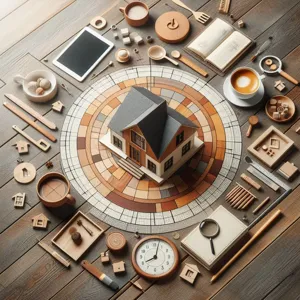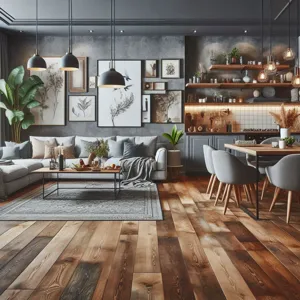Choosing the right flooring for your home is a decision that can significantly impact both the aesthetics and functionality of your living space.
With a myriad of options available, from classic hardwood and cozy carpet to sleek tile and durable laminate, it can be overwhelming to navigate the pros and cons of each type. Each flooring choice brings its own unique blend of benefits and drawbacks, influencing not only the look and feel of your rooms but also your budget, maintenance routine, and long-term satisfaction. In this comprehensive guide, we’ll delve into the distinctive characteristics of various flooring types, exploring the advantages that make them appealing as well as the potential downsides to consider. Whether you’re renovating your home or building anew, this post will equip you with the essential insights needed to make an informed decision that perfectly aligns with your lifestyle and aesthetic goals.
1. Introduction to Flooring Types

When it comes to home design, few decisions are as impactful as choosing the right flooring. The floor beneath our feet serves not only as a functional surface but also as a foundational element that can influence the overall aesthetic and feel of a space. With a myriad of flooring options available today, homeowners and designers alike are often faced with the delightful yet daunting task of navigating these choices.
From the timeless appeal of hardwood to the practicality of vinyl, each flooring type comes with its own set of characteristics, benefits, and drawbacks. Understanding these can help you make an informed decision that aligns with your lifestyle, aesthetic preferences, and budget.
In this comprehensive guide, we will explore the primary flooring types, including hardwood, laminate, tile, carpet, and vinyl, breaking down their unique qualities and helping you weigh the pros and cons of each. Whether you’re embarking on a renovation project, building a new home, or simply looking to refresh your existing space, our insights will equip you with the knowledge you need to choose the perfect flooring that harmonizes with your vision and needs. Join us as we delve into the world of flooring and uncover the options that best suit your home.
2. Hardwood Flooring: Timeless Beauty and Durability
When it comes to flooring that exudes elegance and longevity, hardwood flooring stands as a premier choice for many homeowners. The rich, natural beauty of hardwood adds warmth and character to any space, transforming a house into a home. With a variety of species, finishes, and stains available, hardwood floors can be tailored to fit any aesthetic—from rustic charm to modern sophistication. Each plank tells a story, with unique grain patterns and colors that bring an organic feel to your interiors.
In addition to its stunning appearance, hardwood flooring is renowned for its durability. With proper care and maintenance, hardwood floors can last a lifetime, making them a worthwhile investment. They are less prone to wear and tear compared to other flooring options, resisting scratches and dents when treated with a protective finish. Furthermore, hardwood can be refinished multiple times, allowing you to restore its original luster and adapt to changing design trends without needing a full replacement.
However, it’s important to consider the potential downsides of hardwood flooring. One of the primary concerns is its susceptibility to moisture. While hardwood can handle some humidity, excessive moisture can lead to warping or swelling, making it less ideal for areas like bathrooms or basements. Additionally, hardwood floors can be more expensive upfront compared to alternatives like laminate or vinyl. The installation process may also require professional assistance, which adds to the overall cost.
Another factor to consider is the upkeep. Although hardwood is relatively easy to clean, it does require regular maintenance, such as refinishing and polishing, to keep it looking its best. For homes with pets or young children, this may pose a challenge, as spills and scratches can become more frequent.
In summary, hardwood flooring offers timeless beauty and exceptional durability, making it a top contender for those looking to enhance their living spaces. However, potential buyers should weigh the pros and cons, considering factors such as moisture exposure, cost, and maintenance needs, to determine if it’s the right fit for their home.
3. Laminate Flooring: Affordable and Versatile

Laminate flooring has surged in popularity over the years, and for good reason. This flooring option strikes a perfect balance between affordability and versatility, making it an appealing choice for a wide range of spaces.
One of the standout features of laminate flooring is its cost-effectiveness. Unlike hardwood or natural stone, laminate provides the aesthetic appeal of these premium materials at a fraction of the price. Homeowners can achieve the look of rich oak or sleek slate without breaking the bank. This affordability makes laminate an excellent option for budget-conscious renovations, especially in areas prone to wear and tear, such as entryways and kitchens.
In terms of versatility, laminate flooring is available in a multitude of designs, colors, and finishes, allowing you to find the perfect match for your home’s decor. Whether you prefer the rustic charm of distressed wood or the modern elegance of polished stone, there’s a laminate option that can fit seamlessly into your vision. Additionally, laminate is relatively easy to install, making it a favorite among DIY enthusiasts. Many products feature a click-lock installation system, allowing homeowners to transform their spaces with minimal fuss.
However, it’s important to consider the potential downsides of laminate flooring. While it mimics the look of natural materials, it lacks the authenticity and warmth that comes with genuine wood or stone. Additionally, laminate is not as durable as some other flooring options; it can be prone to scratches and moisture damage if not properly maintained. Once damaged, it’s often challenging to repair, as individual planks may need to be replaced entirely rather than refinished.
In summary, laminate flooring offers a budget-friendly and stylish solution for many homeowners. Its versatility and ease of installation make it a popular choice, especially for those looking to enhance their space without a significant investment. However, it’s essential to weigh these benefits against the potential drawbacks to determine if laminate is the right fit for your needs.
4. Vinyl Flooring: Water-Resistant and Low-Maintenance
Vinyl flooring has rapidly gained popularity among homeowners and designers alike, and for good reason. This versatile flooring option combines practicality with style, making it an excellent choice for various spaces in your home. One of the standout features of vinyl flooring is its impressive water resistance. Unlike traditional hardwood or laminate, vinyl can withstand spills and moisture, making it a perfect fit for areas prone to humidity, such as kitchens, bathrooms, and basements. With advanced manufacturing techniques, modern vinyl flooring mimics the appearance of natural materials, like wood or stone, offering aesthetic appeal without the hefty price tag.
Another significant advantage of vinyl flooring is its low-maintenance nature. Unlike other flooring types that may require polishing, refinishing, or extensive cleaning routines, vinyl is incredibly easy to care for. A simple sweep or vacuum followed by a damp mop is usually all that’s needed to keep it looking pristine. This makes vinyl a fantastic choice for busy households, pet owners, or anyone who prefers a hassle-free cleaning regimen.
However, it’s essential to weigh these benefits against some potential drawbacks. While vinyl flooring is durable and resistant to water, it can be susceptible to scratches and dents from heavy furniture or sharp objects. Additionally, while high-quality vinyl can last for many years, it generally doesn’t match the longevity of materials like hardwood or tile. Homeowners should also consider the environmental impact; while many vinyl products are now made with recycled materials, it is still a synthetic material that may not appeal to those seeking eco-friendly options.
In summary, vinyl flooring offers a compelling mix of water resistance and low maintenance, making it an attractive option for many homeowners. Just be sure to consider your specific needs and the long-term implications of your flooring choice before making a decision.
5. Tile Flooring: A Stylish Choice for Any Room

Tile flooring stands out as a stylish choice for any room, seamlessly blending aesthetics with practicality. Available in a plethora of designs, colors, and textures, tile can mimic the look of natural stone, wood, or even intricate mosaics, giving homeowners the flexibility to express their personal style. Whether you’re aiming for a sleek, modern kitchen or a rustic, cozy bathroom, there’s a tile option that perfectly complements your vision.
One of the most significant advantages of tile flooring is its durability. Resistant to scratches, dents, and moisture, tiles can withstand the rigors of daily life, making them an ideal choice for high-traffic areas like entryways and living rooms. Additionally, tile is easy to clean; spills can be swiftly wiped away, and regular maintenance involves little more than sweeping and mopping. This practicality extends to its hypoallergenic nature, as tile doesn’t harbor dust mites or allergens, promoting a healthier indoor environment.
However, tile flooring does come with its considerations. While it is incredibly durable, it can be cold and hard underfoot, making it less comfortable for prolonged standing or walking compared to softer flooring options. In colder climates, this can be particularly uninviting, requiring the addition of area rugs or underfloor heating systems for added comfort. Furthermore, the installation process can be labor-intensive and costly, especially if intricate patterns or layouts are desired.
In summary, tile flooring offers a stylish and versatile option for any room, combining beauty with durability. With careful consideration of its pros and cons, you can make an informed choice that enhances your home’s aesthetic and functionality, creating spaces that are not only visually appealing but also practical for everyday living.
6. Carpet Flooring: Comfort and Warmth Underfoot
When it comes to creating a cozy and inviting atmosphere in your home, carpet flooring is often the go-to choice for many homeowners. With its plush texture and luxurious feel, carpet offers unparalleled comfort underfoot, making it the perfect option for bedrooms, living rooms, and play areas. Imagine sinking into a soft, warm carpet after a long day – it’s a sensation that instantly promotes relaxation and ease.
One of the standout advantages of carpet flooring is its exceptional insulation properties. Not only does it keep your feet warm during colder months, but it also helps to regulate the overall temperature of a room. This can lead to lower energy costs, as carpets can trap heat and create a more comfortable living environment. Additionally, carpet acts as a natural sound barrier, reducing noise levels and enhancing the tranquility of your space – a significant benefit for busy households or multi-story homes.
However, while the comfort of carpet flooring is undeniable, it does come with its own set of drawbacks. Carpets can be prone to staining and require regular maintenance, including vacuuming and professional cleaning, to keep them looking their best. Allergens and dust mites can also accumulate in the fibers, which may pose issues for those with allergies or respiratory sensitivities. Furthermore, carpets have a limited lifespan compared to hard flooring options, and they may need to be replaced more frequently, adding to long-term costs.
Ultimately, carpet flooring offers a unique blend of comfort and warmth, making it a popular choice for many spaces. However, it’s important to weigh these benefits against the maintenance and longevity considerations to determine if it’s the right fit for your home. By understanding the pros and cons of carpet flooring, you can make an informed decision that aligns with your lifestyle and design preferences.
7. Bamboo Flooring: Eco-Friendly and Sustainable

Bamboo flooring has garnered significant attention in recent years, and for good reason. As homeowners increasingly prioritize eco-friendliness and sustainability, bamboo emerges as a top contender in the flooring market. This natural material, derived from fast-growing bamboo grass, not only boasts a unique aesthetic appeal but also offers an impressive range of benefits.
One of the standout features of bamboo flooring is its sustainability. Unlike traditional hardwood trees, which can take decades to mature, bamboo can reach maturity in just three to five years. This rapid growth means that bamboo can be harvested without depleting natural resources, making it a renewable choice for those looking to minimize their environmental impact. Additionally, many bamboo flooring options are harvested from sustainable forests, ensuring that the harvesting process protects the ecosystem.
From a durability perspective, bamboo flooring is surprisingly strong. It is often compared to oak in terms of hardness, making it an excellent choice for high-traffic areas in the home. With proper care, bamboo can withstand daily wear and tear, maintaining its beauty for years to come. Available in a range of colors and finishes—from light, natural hues to rich, dark stains—bamboo can complement various interior design styles, adding a touch of elegance to any space.
However, it’s essential to consider the drawbacks of bamboo flooring as well. One significant concern is its susceptibility to moisture. Bamboo is not as water-resistant as some other flooring types, which can lead to warping or damage in humid environments. Therefore, it’s crucial to avoid installing bamboo flooring in areas prone to moisture, such as bathrooms or basements. Additionally, while bamboo is generally resistant to scratches, it may require regular maintenance to preserve its finish and prevent wear over time.
In summary, bamboo flooring presents an eco-friendly and visually appealing option for homeowners looking to reduce their carbon footprint without sacrificing style or durability. By weighing the pros and cons, you can make an informed decision about whether this sustainable flooring choice is the right fit for your home.
8. Cork Flooring: Unique Benefits and Considerations
Cork flooring is an increasingly popular choice for homeowners seeking a unique blend of style, sustainability, and comfort. Harvested from the bark of cork oak trees, this eco-friendly material offers several distinct benefits, as well as a few considerations to keep in mind.
One of the standout advantages of cork flooring is its natural insulating properties. Cork acts as a thermal barrier, helping to maintain a comfortable temperature in your home while also providing sound insulation. This means that cork floors can keep your space warmer in the winter and cooler during the summer, all while dampening noise—an ideal feature for homes with bustling families or open-concept layouts.
In addition to its thermal and acoustic benefits, cork is also a soft and resilient material underfoot. Walking on cork feels cushioned, which can be particularly beneficial in high-traffic areas or for individuals with joint issues. Its inherent elasticity reduces the impact on your feet and joints, making it a comfortable choice for kitchens and living rooms.
However, cork flooring does come with some considerations. While it is resistant to mold and mildew, it is not waterproof, meaning spills should be cleaned up promptly to prevent damage. Additionally, cork can be sensitive to direct sunlight, which may cause it to fade over time. To protect its vibrant color and prolong its lifespan, it is advisable to use area rugs in sun-drenched spots and to maintain a consistent cleaning routine.
Lastly, while cork flooring can be an attractive investment, it tends to be on the pricier side compared to other flooring options like laminate or vinyl. However, its unique aesthetic appeal, coupled with its sustainability and comfort, can make it a worthwhile addition to your home if you seek a distinctive and practical flooring solution.
In summary, cork flooring offers a unique blend of benefits, from its eco-friendly credentials to its comfort underfoot. By weighing these advantages against the considerations of maintenance and cost, you can make a well-informed decision about whether cork is the right fit for your space.
9. Concrete Flooring: Industrial Aesthetic and Longevity
Concrete flooring has surged in popularity over recent years, particularly among homeowners and businesses seeking a blend of modern aesthetics and durability. This flooring type, often associated with an industrial look, provides a unique and versatile foundation for a variety of design styles, from minimalist to rustic. Its natural gray hue offers a neutral backdrop that can complement various color schemes and furnishings, while the option to stain or polish the surface opens up a world of creative possibilities.
One of the standout features of concrete flooring is its longevity. Unlike softer flooring materials that can succumb to wear and tear over time, concrete is incredibly tough and resistant to scratching, denting, and staining. This makes it an excellent choice for high-traffic areas, whether it’s a bustling entryway or a lively family room. Additionally, concrete is inherently moisture-resistant, making it suitable for basements and other areas prone to dampness.
However, potential buyers should also consider the drawbacks of concrete flooring. While it’s undoubtedly durable, concrete can be unforgiving underfoot, often feeling cold and hard, which may not be the most comfortable option for standing or walking for long periods. This can be mitigated with the addition of area rugs or cushioned mats, but it’s an important factor to keep in mind. Furthermore, installation can be labor-intensive and costly, especially if you opt for decorative finishes, which can add to the overall expense.
In summary, concrete flooring presents a striking industrial aesthetic and remarkable longevity that appeals to many. Yet, it’s essential to weigh these advantages against its potential downsides, ensuring that it aligns with your lifestyle and design vision. Whether you’re renovating a home or outfitting a commercial space, concrete flooring could be the perfect fit if you appreciate its unique characteristics and are willing to invest in the right enhancements for comfort and style.
10. Factors to Consider When Choosing Flooring
Choosing the right flooring for your space is a decision that encompasses a variety of factors, each playing a pivotal role in ensuring your selection not only meets aesthetic desires but also functional needs. To navigate this process effectively, consider the following key aspects:
**1. Purpose of the Space:** The intended use of the room dramatically influences your flooring choice. High-traffic areas, such as hallways and living rooms, may require durable materials like hardwood or tile that can withstand wear and tear, while cozy spaces like bedrooms might benefit from softer options like carpet or cork that provide warmth and comfort.
**2. Maintenance Requirements:** Every flooring type comes with its own upkeep needs. For instance, while hardwood floors can add timeless elegance, they often require regular polishing and care to maintain their luster. On the other hand, luxury vinyl plank is not only stylish but also easy to clean and maintain, making it an attractive option for busy households.
**3. Climate Considerations:** Your local climate can affect the longevity and performance of your flooring. In humid areas, for example, opt for moisture-resistant options like tile or vinyl, as hardwood can warp under excessive moisture. Conversely, in dryer climates, carpets may trap dust and allergens, requiring more frequent cleaning.
**4. Budget Constraints:** Flooring can range from budget-friendly options to high-end materials. It’s essential to balance your aesthetic preferences with your financial capabilities. While investing in premium materials may yield long-term benefits, there are also plenty of cost-effective solutions that provide beauty and durability without breaking the bank.
**5. Environmental Impact:** Sustainable choices are increasingly important for many homeowners. Consider flooring options made from renewable resources, such as bamboo or reclaimed wood, which not only contribute to a healthier planet but can also elevate the unique character of your space.
**6. Aesthetic Appeal:** Finally, the look and feel of your flooring should resonate with your personal style and complement existing decor. From the rich tones of hardwood to the sleek finish of polished concrete, the visual impact of your flooring choice can set the tone for the entire room.
By carefully weighing these factors, you can make a well-informed decision that aligns with both your practical needs and design aspirations, ultimately creating a flooring solution that enhances your living space for years to come.
11. Cost Comparisons: Budgeting for Your Flooring Project
When embarking on a flooring project, one of the most critical considerations is your budget. Different flooring types come with varying price tags, and understanding these cost comparisons can help you make an informed decision that aligns with your financial plan.
First, let’s break down some of the most common flooring options. **Hardwood flooring**, while undeniably beautiful and durable, can be on the higher end of the spectrum, often costing between $8 to $14 per square foot, depending on the type of wood and finish. However, its timeless appeal and longevity can make it a worthwhile investment for many homeowners.
On the other hand, **laminate flooring** offers a budget-friendly alternative, typically ranging from $1 to $5 per square foot. With advancements in technology, laminate can mimic the look of hardwood or tile while being more resistant to scratches and moisture, making it a smart choice for families with pets or young children. Just be mindful that while laminate is cost-effective, it may not add the same resale value as hardwood.
**Vinyl flooring** is another budget-conscious option that has gained popularity for its versatility and ease of installation. Prices generally fall between $2 to $7 per square foot. Vinyl is available in planks, tiles, and sheets, making it suitable for a variety of spaces, including kitchens and bathrooms, where moisture resistance is crucial.
For those seeking a more luxurious feel, **carpet** can range from $2 to $10 per square foot, depending on the fiber and pile. While it offers warmth and comfort underfoot, keep in mind that maintenance costs, such as cleaning and potential replacement due to wear and tear, should be factored into your overall budget.
Lastly, **natural stone**, like marble or granite, can elevate any space but comes with a hefty price tag, often ranging from $5 to $25 per square foot. While stunning, its high cost and the need for professional installation can be a significant investment.
When budgeting for your flooring project, consider not only the initial costs but also the long-term value, maintenance, and potential for replacement. Creating a well-rounded budget that includes the price of materials, labor, and any necessary underlayment or preparation work will yield a clearer picture of what you can afford. By weighing the pros and cons of each flooring type alongside your budget, you can navigate the many options available and choose the perfect flooring solution for your home.
12. Maintenance Requirements for Different Flooring Types
When it comes to choosing the right flooring for your home, understanding the maintenance requirements of various types can be a game-changer. Each flooring option has its own set of care needs, which can significantly impact your long-term satisfaction and the overall upkeep of your space. Here’s a closer look at the maintenance demands of popular flooring types to help you make an informed decision.
**Hardwood Flooring**
Hardwood floors are a timeless choice known for their beauty and longevity. However, they require regular maintenance to keep them looking pristine. Routine sweeping or vacuuming is essential to remove dust and debris, while periodic mopping with a pH-balanced cleaner helps prevent scratches and dullness. Additionally, hardwood floors need to be refinished every few years to restore their luster and protect against wear. While this maintenance requires an investment of time and resources, the result is a stunning and durable flooring option that can last for generations.
**Laminate Flooring**
Laminate flooring offers the aesthetic appeal of hardwood or stone without the hefty price tag. One of its biggest advantages is its low maintenance requirements. Regular sweeping and occasional damp mopping will keep laminate floors looking fresh and clean. Unlike hardwood, laminate doesn’t require refinishing; however, it’s crucial to avoid excessive moisture, as it can warp the material. This makes laminate an excellent option for those seeking a beautiful floor with minimal upkeep.
**Tile Flooring**
Tile flooring, whether ceramic or porcelain, is highly durable and resistant to moisture, making it a popular choice for kitchens and bathrooms. While tile is relatively easy to clean—requiring just regular sweeping and mopping—it does have grout lines that can accumulate dirt and mildew. To maintain tile floors, periodic grout cleaning is necessary, and sealing the grout can help prevent staining. While tile can be a bit more labor-intensive in terms of maintenance, its longevity and resistance to wear make it a worthwhile investment.
**Vinyl Flooring**
Vinyl flooring is celebrated for its versatility and ease of maintenance. It’s resistant to moisture, stains, and scratches, requiring little more than regular sweeping and occasional mopping to keep it looking its best. Unlike some other flooring types, vinyl doesn’t need refinishing or sealing, making it a hassle-free option for busy households. However, it’s important to avoid harsh chemicals that can damage the surface over time.
**Carpet**
Carpet offers warmth and comfort, but it comes with its own set of maintenance challenges. Regular vacuuming is essential to reduce dust and allergens, and professional deep cleaning is recommended every 12 to 18 months to maintain its appearance and hygiene. Carpets can be susceptible to stains, so prompt action is necessary to treat spills and accidents. While carpet can provide a cozy atmosphere, be prepared for a little more effort in keeping it clean and fresh.
Ultimately, the choice of flooring type should align with your lifestyle, aesthetic preferences, and willingness to engage in maintenance. By weighing the pros and cons of each option, you can select the flooring that best meets your needs while ensuring a beautiful and functional space for years to come.
13. Environmental Impact of Flooring Choices
When it comes to choosing the right flooring for your space, one of the most significant factors to consider is the environmental impact of your options. As sustainability becomes an increasingly important consideration for homeowners and builders alike, understanding how different flooring materials affect the planet is essential to making an informed decision.
**Sustainable Choices**
Many modern flooring options prioritize eco-friendliness. For instance, bamboo and cork are often hailed as sustainable choices due to their rapid growth rates and renewability. Bamboo, which can grow several feet in just a single day, is a grass rather than a tree, making it a highly renewable resource. Similarly, cork is harvested from the bark of cork oak trees, which can regenerate their bark, allowing for repeated harvests without causing harm to the tree.
Reclaimed wood flooring is another environmentally responsible option. By repurposing old wood, you’re not only minimizing waste but also preserving the history and character of the material. Additionally, many manufacturers are now producing flooring made from recycled materials, such as rubber and vinyl, which reduces landfill waste and promotes a circular economy.
**The Downsides**
However, not all flooring materials are created equal when it comes to environmental impact. Traditional hardwood flooring often involves deforestation, which can lead to habitat loss and increased carbon emissions. The production processes for certain materials, like laminate or vinyl, can also involve harmful chemicals and contribute to pollution.
Even seemingly green choices can have hidden environmental costs. For example, while bamboo is a rapidly renewable resource, its widespread popularity has led to unsustainable harvesting practices in some regions. Furthermore, the long-distance transportation of materials can contribute to a larger carbon footprint, negating some of the benefits of choosing a sustainable option.
**Making Informed Choices**
Ultimately, navigating the environmental impact of flooring choices requires a balanced approach. Research the sourcing and production practices of the materials you’re considering, and look for certifications that indicate sustainability, such as the Forest Stewardship Council (FSC) label or GREENGUARD certification. By prioritizing eco-friendly options while remaining mindful of potential downsides, you can select flooring that not only enhances your space but also aligns with your values for a healthier planet.
14. Making the Right Choice for Your Lifestyle
Choosing the right flooring for your home is not just about aesthetics; it’s about aligning your selection with your lifestyle and needs. The perfect flooring option should complement how you live, work, and play in your space. Here are some key considerations to help you make the right choice.
**Consider Your Daily Routine:** If you have a bustling household with kids and pets, durability should be at the forefront of your decision-making process. Options like luxury vinyl or laminate flooring are both resilient and easy to clean, standing up to spills and scratches with ease. On the other hand, if you lead a quieter lifestyle or live alone, you might prioritize comfort and style, making hardwood or carpet a more suitable choice.
**Evaluate Maintenance Needs:** Different flooring types come with varying levels of maintenance. For instance, natural stone and hardwood may require regular sealing and polishing to maintain their beauty, while tile and vinyl are generally more forgiving. If you have a busy schedule and prefer a low-maintenance solution, opting for materials that require less upkeep can save you time and hassle in the long run.
**Climate Considerations:** Your geographical location and climate can significantly impact your flooring choice as well. In areas with high humidity, such as coastal regions, materials like bamboo or treated engineered wood can be more stable and resistant to moisture damage. Conversely, in dry climates, you may want to avoid certain types of hardwood that are prone to warping.
**Your Budget:** Finally, budget plays a crucial role in your decision-making process. While it’s tempting to go for the most luxurious options, remember that there are high-quality flooring materials available at various price points. Consider the long-term value and durability of your investment. Sometimes, spending a bit more upfront on a durable option can save money on repairs and replacements later.
Ultimately, the right flooring choice for your lifestyle will harmonize with your daily life, enhance your home’s functionality, and reflect your personal taste. Take your time to weigh the pros and cons of each flooring type, and you’ll be on your way to creating a space that truly feels like home.
15. Conclusion: Finding the Perfect Flooring for Your Space
Choosing the right flooring for your space is no small feat. With an array of options available—from the natural warmth of hardwood to the sleek sophistication of tile, and the cozy embrace of carpet to the low-maintenance allure of vinyl—finding the perfect fit can feel overwhelming. However, by weighing the pros and cons of each type and considering the specific needs of your lifestyle and aesthetic preferences, you can make an informed decision that enhances both the functionality and beauty of your home.
As you assess your options, think about the environment in which the flooring will be used. For high-traffic areas, durable materials like laminate or tile may be better suited, while softer options like carpet could be ideal for cozy bedrooms. Don’t forget about maintenance and care; some flooring types require more effort to keep them looking their best, while others offer a hassle-free experience.
Budget considerations also play a crucial role. While the initial investment in hardwood or luxury vinyl may be higher, the long-term benefits—such as durability and resale value—might make them worth every penny. Conversely, if you’re looking for something more affordable, options like laminate or carpet can still provide style without breaking the bank.
Ultimately, the perfect flooring for your space should reflect your personal style, cater to your family’s needs, and fit your budget. Take the time to explore samples, envision how each option will harmonize with your existing decor, and consult with flooring experts if necessary. With thoughtful consideration, you’ll find a flooring solution that not only meets your practical requirements but also transforms your space into a welcoming sanctuary that you and your guests will love for years to come.
As we conclude our exploration of the various flooring types, we hope you feel empowered to make a well-informed decision that aligns with your lifestyle and aesthetic preferences. Each flooring option we discussed comes with its unique set of advantages and drawbacks, allowing you to weigh them against your specific needs and budget. Whether you lean toward the warmth of hardwood, the durability of laminate, or the elegance of tile, understanding the pros and cons is crucial for creating a space that reflects your style while standing the test of time. Remember, selecting the right flooring is not just about appearance—it’s about enhancing your home’s comfort and functionality. We encourage you to take this newfound knowledge to heart, explore your options, and choose the flooring that will lay the foundation for years of joy and memories in your home. Happy flooring!






